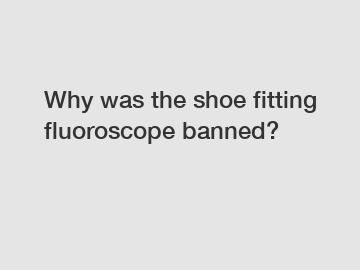Why was the shoe fitting fluoroscope banned?
Why was the shoe fitting fluoroscope banned?
The shoe fitting fluoroscope, a device used in the 1920s to ensure the proper fit of footwear, was eventually banned due to its harmful health effects. This article delves into the reasons behind the ban, the process of substantiating the evidence, and the significance and impact of this decision.
In the early 20th century, shoe stores introduced fluoroscopes to provide customers with an innovative method of ensuring the perfect shoe fit. The device used X-rays to create a real-time image of the feet inside the shoes, allowing the salesperson and customer to see the bones and how they aligned with the shoes. It was believed that this enhanced visibility would lead to improved fitting and increased customer satisfaction. However, the use of X-rays in this manner posed severe health risks.

As early as the 1920s, concerns began to arise regarding the safety of the shoe fitting fluoroscope. Medical experts and scientists started questioning the long-term effects of regular exposure to X-rays. They raised concerns about the potential radiation damage to the feet and other parts of the body, as well as the cumulative effects of repeated exposure over time. Consequently, researchers initiated studies to evaluate the hazards associated with using the device.
Over time, the evidence against the shoe fitting fluoroscope gathered momentum. Studies showed that the radiation exposure from the device was far higher than what was considered safe, even resulting in radiation burns on the feet of regular users. It became apparent that the benefits of using the fluoroscope did not outweigh the health risks it posed.
In response to these findings, regulatory bodies, such as the Food and Drug Administration (FDA) in the United States, took action. They imposed bans on the use of the shoe fitting fluoroscope in several countries, effectively putting an end to its implementation in shoe stores. This decision marked a significant step in ensuring public safety and holding businesses accountable for the products they introduced to the market.
The banning of the shoe fitting fluoroscope had a lasting impact on the shoe retail industry. It prompted manufacturers to seek alternative methods for ensuring shoe fit without endangering customer health. Over time, new techniques such as foot scanning and 3D modeling emerged, allowing for accurate measurements and fitting assessments without the need for harmful radiation. These advancements not only provided a safer shopping experience but also revolutionized the way customers choose and purchase shoes.
In conclusion, the shoe fitting fluoroscope was ultimately banned due to the health risks associated with exposure to X-rays. The evidence gathered through research and studies substantiated the dangers and led to proactive regulatory action. This decision not only prioritized public safety but also paved the way for innovative alternatives that improved the shoe fitting process. By learning from the mistakes of the past, we continue to progress towards safer and more efficient solutions in the world of fashion retail.
If you are looking for more details, kindly visit food industry footwear, pvc rubber boots, pvc safety boots for chemcial industry.
173
0
0


Comments
All Comments (0)